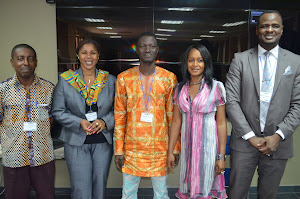By Edmund Smith-Asante, SAVELUGU
 |
| Mr Bansaga Saga taking journalists through the different latrine models. |
Engineering expertise has been
overlooked in the Community Led Total Sanitation (CLTS) approach adopted by the
government to improve rural sanitation coverage, the Project Manager of World
Vision’s Ghana Integrated Water, Sanitation and Hygiene (GI-WASH) programme, Mr
Bansaga Saga, has stated.
He, therefore, advocated the attachment
of sanitation engineers to all the districts to oversee latrine construction,
which, he said, would come at a cost because the engineers would have to be
paid.
“Because we are not financing the
sanitation, who should pay for that quality cost,” he asked.
Ghana in 2010 adopted the Community
Led Total Sanitation (CLTS) approach to improve rural sanitation and also deal
with the high incidence of open defecation in the country.
A do-it-yourself approach
Mr Saga said currently, employing
the CLTS model means that “you have to do it by yourself. How do we ensure the
all these people doing it by themselves can maintain the minimum standard in
terms of engineering?”
He indicated that the closest that
the CLTS had come to streamlining latrines built was the institution of
sanitation markets that showcased different latrine models and also building
the capacity of local artisans in the construction of latrines.
He lamented that apart from that, no
attempt had been made to guide individuals who constructed the latrines with
engineering expertise, to ensure that durable materials were used or that
proper engineering methods were employed.
Mr Saga said he had witnessed the
collapse of several pits dug for latrines as well as concrete slaps put on
pits. He said “basically there is no technology to stabilise it other than to
use concrete blocks. You can find some wood and put them on the pit and put
clay on them but termites will eat them.”
He indicated that as there were some
areas that did not have strong woods, covering the pits became a challenge.
“That means covering the pit with iron, cement and all, which immediately goes
beyond the capacity of the individual,” he stated.
According to him although World
Vision appreciated the challenges, they were constrained by the CLTS policy,
which does not allow any form of support but rather encourages full local
involvement and the use of local materials for latrine construction.
He however, noted that stakeholders
were currently brainstorming to see if they could influence an amendment of the
current policy to be able to meet individuals halfway in the construction of
latrines after they had reached a certain stage.
Writer’s email: edmund.asante@graphic.com.gh
This
story was first published by the Daily Graphic on September 30, 2015





No comments:
Post a Comment